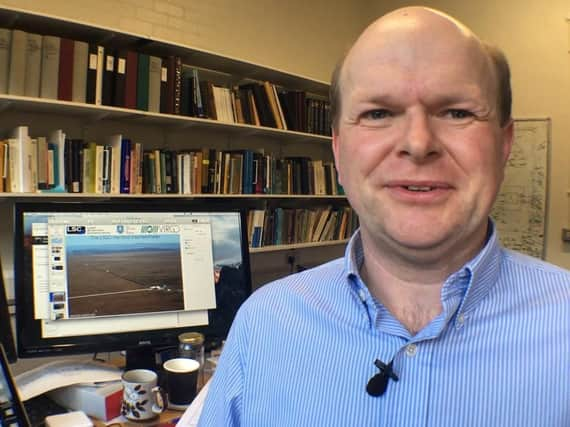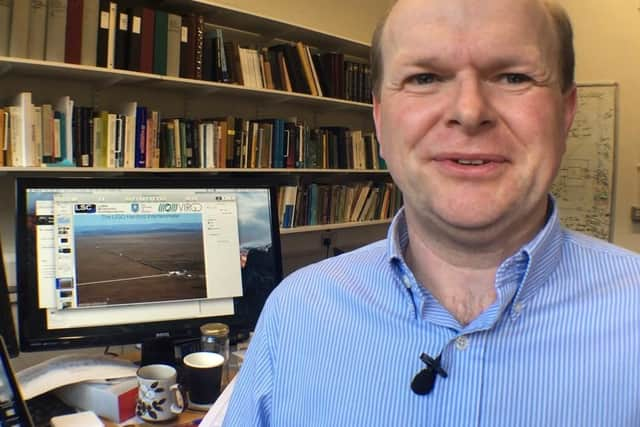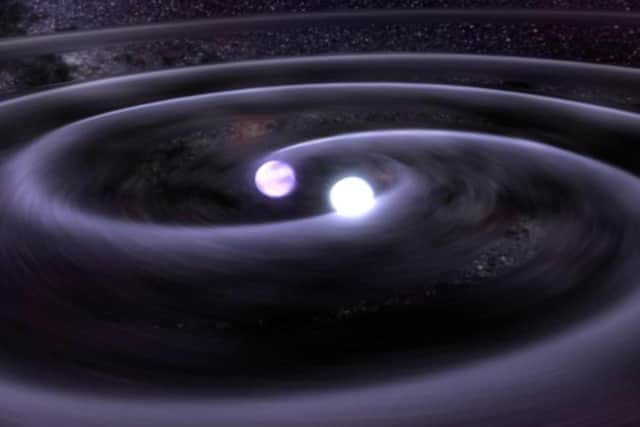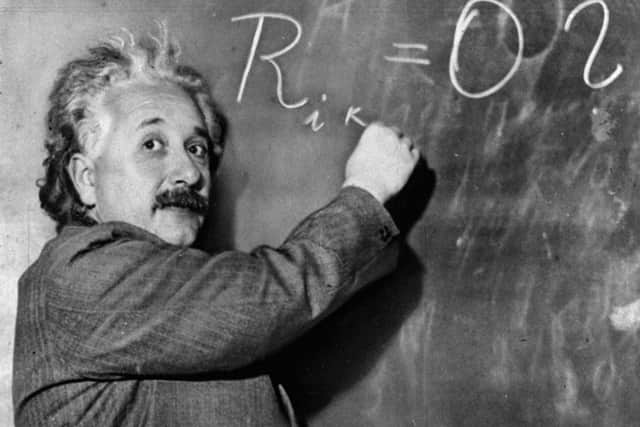MAJOR SPACE DISCOVERY: Sheffield University helps unlock new wonders of the universe


They have helped to prove the existence of space distorting gravitational waves - first predicted 100-years ago by Albert Einstein, but never before seen until now.
Gravitational waves are ripples in space-time, which carry information about space phenomena never before observed.
Advertisement
Hide AdAdvertisement
Hide AdBoffins hope, unlike using a traditional telescope, Gravitational Wave astronomy will now help us to understand some of the most violent events in the cosmos, including exploding stars, colliding black holes, perhaps even the Big Bang itself.
When microwave observations first found faint imprints of the Big Bang, Stephen Hawking called it the "greatest discovery of the century, if not all time". Today's announcement is another giant leap for mankind.
Dr Ed Daw, of the Physics Department at the University of Sheffield, helped with the research leading to the history making global announcement this afternoon at simultaneous press conferences in Washington DC, Louisiana, London and Paris,
Before joining Sheffield he worked for five years at LIGO (Laser Interferometer Gravitational-Wave Observatory), in the USA.


Advertisement
Hide AdAdvertisement
Hide AdDr Daw has been working on gravitational wave data analysis, as a member of the LIGO scientific collaboration.
Explaining today's announcement - watch our video report here - he said: "Today is a great day for the type of science I do.
"LIGO and the collaborators working on it, including the University of Sheffield, are announcing the discovery of gravitational waves for the first time - from a source which went off more than 100 million years ago. We couldn't be more thrilled with this great announcement. We look forward to the future of the science of the field."
Dr Daw, who has been researching gravitational waves with LIGO since 1998, added: “Discoveries of this importance in Physics come along about every 30 years.


Advertisement
Hide AdAdvertisement
Hide Ad“A measure of its significance is that even the source of the wave – two black holes in close orbit, each tens of times heavier than the sun, which then collide violently, has never been observed before, and could not have been observed by any other method.
“This is just the beginning.”


Albert Einstein's theory of general relativity first predicted the existence of the mysterious waves in 1916. He believed that cataclysmic events such as two black holes colliding would create the waves, which allow massive objects in space to become curved.
Advertisement
Hide AdAdvertisement
Hide AdBut only now has super sensitive equipment been developed to detect them.
LIGO uses 4km-long pipes to detect the waves, 3000 kilometres apart, in Washington and Louisiana. They pick up passing gravitational waves by measuring how space-time stretches and contracts – by as little as one ten-thousandth the diameter of a proton.
It confirms that massive objects like black holes and neutron stars warp space-time around themselves, and when two collide the distortions ripple outward at the speed of light..
Physicists have revealed the first gravitational waves they detected were produced in the final fraction of a second during the merger of two black holes, which produced a single, more massive spinning black hole. The collision of two black holes had been predicted by Einstein, but never observed before.
Advertisement
Hide AdAdvertisement
Hide AdThe gravitational waves were detected on September 14, 2015 at 5:51 am (Eastern Daylight Time) by both of the twin Laser Interferometer Gravitational-wave Observatory (LIGO) detectors, located in Livingston, Louisiana, and Hanford, Washington, USA.


Based on the signals observed, LIGO scientists estimate that the black holes, from which the gravitational waves were detected, were about 29 and 36 times the mass of the sun, and collided around 1.3 billion years ago.
The gravitational waves detected were about three times the mass of the sun which had been converted in a fraction of a second – with a peak power output about 50 times that of the whole visible universe.
According to general relativity, a pair of black holes orbiting around each other lose energy through the emission of gravitational waves, causing them to gradually approach each other over billions of years, and then much more quickly in the final minutes.
Advertisement
Hide AdAdvertisement
Hide AdDuring the final fraction of a second, the two black holes collide into each other at nearly one-half the speed of light and form a single more massive black hole, converting a portion of the combined black holes’ mass to energy, according to Einstein’s formula E=mc2. This energy is emitted as a final strong burst of gravitational waves. It is these gravitational waves that LIGO observed.
Dr Daw explained: “Imagine that your TV had only ever received one channel on which the shows were all rather similar to each other.
“One day a second one appeared which shows completely different programs, like nothing that had ever been broadcast on the old channel. Wouldn’t you want to switch over?
“By detecting this signal, LIGO has effectively tuned into a new channel – a completely new way of observing the universe.”
Advertisement
Hide AdAdvertisement
Hide AdHe added: “Gravitational waves are so completely different from light, we’re probably only just beginning to understand how they reflect and shape our Universe.
“For example, a gravitational wave will propagate almost completely unaltered through entire planets, star systems, galaxies… this is so completely different from the radio waves that your mobile phone picks up – even getting too close to a building can disrupt those signals.
“Light, or more generally electromagnetic waves, are so much more vulnerable to interference than gravitational waves.”
LIGO research is carried out by the LIGO Scientific Collaboration (LSC), a group of more than 1000 scientists from universities from 15 countries around the globe - including the University of Sheffield.
Advertisement
Hide AdAdvertisement
Hide AdProfessor Sir Keith Burnett, Vice-Chancellor of the University of Sheffield and eminent physicist, said: “I am stunned and totally delighted to hear that gravitational waves have been detected for the first time by a team that includes physicists from Sheffield.
“This gives us a unique way of seeing the most formidable and violent of gravitational phenomena in the universe. To have seen the ripples in spacetime generated by colliding black holes is a truly magnificent achievement.
“When I think of all the dedicated technical brilliance that has gone into this wonderful breakthrough I feel quite humble.”
He added: “The courage to work for many decades, with such profound technical challenges, guided only by Einstein's theory, deserves the greatest of scientific accolades.
Advertisement
Hide AdAdvertisement
Hide Ad“I have seen glimpses of the work that has gone into developing the extraordinary instrumentation that the physicists have used. It has filled me with deep admiration for this achievement. We must salute these pioneers who have opened our new view of the universe.”
The LIGO Observatories are funded by the National Science Foundation (NSF), and were conceived, built, and are operated by Caltech and MIT. The discovery, accepted for publication in the journal Physical Review Letters, was made by the LSC (which includes the GEO Collaboration and the Australian Consortium for Interferometric Gravitational Astronomy) and the Virgo Collaboration using data from the two LIGO detectors.
More than 90 universities and research institutes in the LSC developed detector technology and analysed data; approximately 250 students are strong contributing members of the collaboration. The LSC detector network includes the LIGO interferometers and the GEO600 detector. The GEO team includes scientists at the Max Planck Institute for Gravitational Physics (Albert Einstein Institute, AEI), Leibniz Universität Hannover, along with partners at the University of Sheffield, University of Glasgow, Cardiff University, the University of Birmingham, other universities in the United Kingdom, and the University of the Balearic Islands in Spain.
LIGO was originally proposed as a means of detecting these gravitational waves in the 1980s by Rainer Weiss, professor of physics, emeritus, from MIT; Kip Thorne, Caltech’s Richard P. Feynman Professor of Theoretical Physics, emeritus; and Ronald Drever, professor of physics, emeritus, also from Caltech.
Advertisement
Hide AdAdvertisement
Hide AdVirgo research is carried out by the Virgo Collaboration, consisting of more than 250 physicists and engineers belonging to 19 different European research groups: six from Centre National de la Recherche Scientifique (CNRS) in France; eight from the Istituto Nazionale di Fisica Nucleare (INFN) in Italy; two in The Netherlands with Nikhef; the Wigner RCP in Hungary; the POLGRAW group in Poland and the European Gravitational Observatory (EGO), the laboratory hosting the Virgo detector near Pisa in Italy.The discovery was made possible by the enhanced capabilities of Advanced LIGO, a major upgrade that increases the sensitivity of the instruments compared to the first generation LIGO detectors, enabling a large increase in the volume of the universe probed—and the discovery of gravitational waves during its first observation run. The US National Science Foundation leads in financial support for Advanced LIGO. Funding organisations in Germany (Max Planck Society), the UK. (Science and Technology Facilities Council, STFC) and Australia (Australian Research Council) also have made significant commitments to the project. Several of the key technologies that made
Advanced LIGO so much more sensitive have been developed and tested by the German UK GEO collaboration. Significant computer resources have been contributed by the AEI Hannover Atlas Cluster, the LIGO Laboratory, Syracuse University, and the University of Wisconsin-Milwaukee. Several universities designed, built, and tested key components for Advanced LIGO: The Australian National University, the University of Adelaide, the University of Florida, Stanford University, Columbia University in the City of New York, and Louisiana State University.